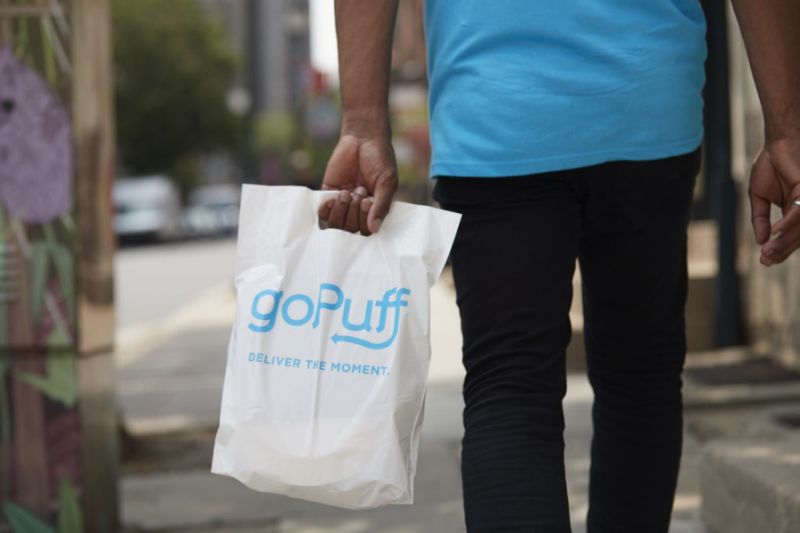
- goPuff’s delivery volume rose 400% in the first half of 2020, according to sources
- goPuff now reaches 500 cities through over 200 distribution facilities
- Raised $1 billion from investors including Accel and SoftBank
- Vertical integration provides better customer experience and margins
- goPuff’s rapid expansion gives it head start and wide moat versus potential rivals
- History of fiscal responsibility points to strong underlying unit economics
The coronavirus didn’t just cause a spike in demand for local delivery, it more likely accelerated a need for convenience that consumers will expect forever. But with so many players in the game, investors need a discerning eye to spot the technology companies that will endure.
One under-the-radar company to watch: goPuff, a seven-year-old “consumer technology” firm focused on delivering all manner of needs from diapers to beer to cold medicine – in 30 minutes or less and for a flat fee of $1.95. The idea for goPuff was originally cooked up by two Drexel University students, co-CEOs Yakir Gola and Rafael Ilishayev, who have expanded from one campus to 500 cities supported by more than 200 distribution facilities.
To understand what sets goPuff apart, it’s important to see where others have stumbled. Much of today’s last-mile delivery – be it restaurant meals, liquor, or groceries – is handled by third parties such as GrubHub Inc., Drizly, and Instacart.
Such business models can be unpleasant for both consumers – who discover aggressive markups and unpredictable inventory – and retailers – who find their margins squeezed and customer relationships hijacked. In many cases, the third parties themselves face fierce competition that forces them to consolidate: Just witness the frantic dealmaking by Uber Technologies, Inc. GrubHub, Postmates, and others.
But goPuff, which operates in a unique category of its own, can avoid all of those challenges thanks to a vertically-integrated model. The company, whose backbone is a logistics technology platform, gets items directly from manufacturers, manages them in owned distribution facilities, and delivers them to doorsteps through a fleet of drivers.
Such a model eliminates uncertainty around inventory, allows optimized scheduling, and is free from dependence on local retailers. goPuff’s technology allows it to optimize picking, packing, and even routes for drivers. In turn, the company can ensure faster, more accurate orders than any third party operator.
goPuff has also proven to be highly scalable. Delivery volume rose 400% in the first half of 2020, according to people familiar with the matter. The company’s staff quadrupled in 2019, now totaling 4,000 and growing.
goPuff is appears to be a more attractive employer for drivers as well. Unlike an Uber Eats or GrubHub gig, a driving job with goPuff always has the same pickup point – reducing time spent at grocers or restaurants that were never designed to handle heavy takeout volume.
The company’s expansion, which has been known to consumers but perhaps less to the financial and media community, has given it a head start and a wide moat. In addition to its strong relationship with customers, the company stocks a wide assortment of 3,000 or more items. goPuff also has taken time-consuming steps such as securing liquor licenses, which can take a couple of years in some places.

Further expansion is likely afoot. And when goPuff enters new cities, it doesn’t depend on local partners to get started. (Though goPuff does sometimes team up with hometown favorites, such as Federal Donuts in Philadelphia).
There are likely many more cities or dense suburban areas where goPuff can find success beyond its current 500 locations. Looking further ahead, the company’s proprietary software could also work internationally in countries where quick delivery is also in demand.
goPuff’s recent rapid growth was helped partly by a second round of funding from Palo Alto venture capital heavyweight Accel last year. Accel was joined by Masayoshi Son’s Softbank Group Corp, who helped bring goPuff’s total funding to $1 billion.
However, it is important to note that goPuff has fiscal responsibility in its DNA. The company was bootstrapped in its early years, relying on cash its founders raised from side jobs such as buying and selling furniture online.
While the company has not disclosed financials, its early history of self funding points to an underlying business model with strong unit economics. The fresh capital from Accel and others allowed it to accelerate capital expenditures, building out distribution facilities to extend its lead over rivals.
That financial approach sets goPuff apart from many “unicorns” that have struggled in recent years. Companies that have gone public – or tried – such as WeWork, Lyft, Inc. and Uber fell out of favor with investors because they couldn’t show a clear path to profitability.
There are other ways for goPuff to drive revenue with minimal additional investment. While once offering strictly convenience-store items, the company has expanded into new categories such as baby care and over-the-counter medicine. That is likely to increase the average order size over time as customers notice new items to tack on.
Of course, there may be worries that Amazon.com, Inc., the world’s largest company by market capitalization, could put a squeeze on a rising challenger like goPuff. But Amazon simply doesn’t have the local distribution footprint to compete. It is more likely Amazon or another large player would see goPuff as an acquisition target to improve its local delivery game.
It is somewhat challenging to find a comparable company to benchmark goPuff’s scale or growth. The company’s consumer-focused technology platform puts it in a category of its own.
For now, there are no indications that goPuff plans to sell itself or go public. But one thing is clear: when goPuff moves, it tends to be quick.
Contact:
John Jannarone, Editor-in-Chief
<p class="canvas-atom canvas-text Mb(1.0em) Mb(0)–sm Mt(0.8em)–sm" type="text" content="www.IPO-Edge.com” data-reactid=”60″>www.IPO-Edge.com
<p class="canvas-atom canvas-text Mb(1.0em) Mb(0)–sm Mt(0.8em)–sm" type="text" content="[email protected]” data-reactid=”61″>[email protected]
<p class="canvas-atom canvas-text Mb(1.0em) Mb(0)–sm Mt(0.8em)–sm" type="text" content="Twitter: @IPOEdge” data-reactid=”62″>Twitter: @IPOEdge
<p class="canvas-atom canvas-text Mb(1.0em) Mb(0)–sm Mt(0.8em)–sm" type="text" content="Instagram: @IPOEdge” data-reactid=”63″>Instagram: @IPOEdge






